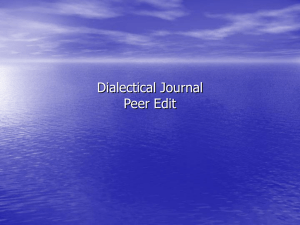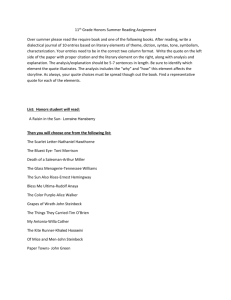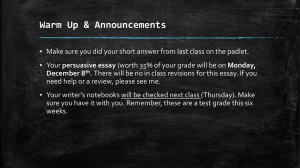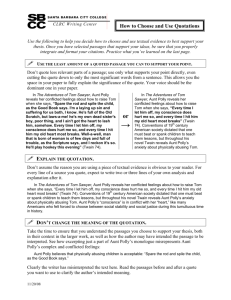Using Textual Evidence (Quotes)
advertisement
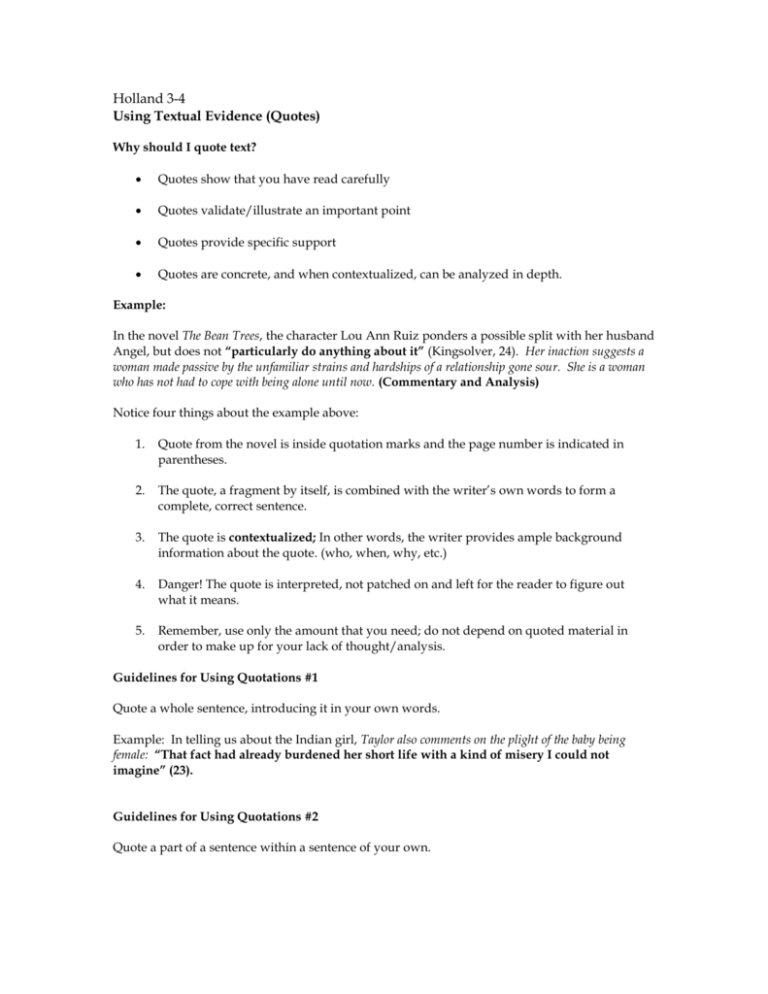
Holland 3-4 Using Textual Evidence (Quotes) Why should I quote text? Quotes show that you have read carefully Quotes validate/illustrate an important point Quotes provide specific support Quotes are concrete, and when contextualized, can be analyzed in depth. Example: In the novel The Bean Trees, the character Lou Ann Ruiz ponders a possible split with her husband Angel, but does not “particularly do anything about it” (Kingsolver, 24). Her inaction suggests a woman made passive by the unfamiliar strains and hardships of a relationship gone sour. She is a woman who has not had to cope with being alone until now. (Commentary and Analysis) Notice four things about the example above: 1. Quote from the novel is inside quotation marks and the page number is indicated in parentheses. 2. The quote, a fragment by itself, is combined with the writer’s own words to form a complete, correct sentence. 3. The quote is contextualized; In other words, the writer provides ample background information about the quote. (who, when, why, etc.) 4. Danger! The quote is interpreted, not patched on and left for the reader to figure out what it means. 5. Remember, use only the amount that you need; do not depend on quoted material in order to make up for your lack of thought/analysis. Guidelines for Using Quotations #1 Quote a whole sentence, introducing it in your own words. Example: In telling us about the Indian girl, Taylor also comments on the plight of the baby being female: “That fact had already burdened her short life with a kind of misery I could not imagine” (23). Guidelines for Using Quotations #2 Quote a part of a sentence within a sentence of your own. Example: Taylor demonstrates an acute understanding of the irony of the world when she comments that Indians “can be cowboys too, though probably not vice versa” (15). Analysis should continue here… Guidelines for Using Quotations #3 Quote just one or a few words within a sentence of your own. Example: Taylor sees the possibility of her life laid out like a “hooked bass” (11). Commentary to follow… Guidelines for Using Quotations #4 Use an ellipsis (…) to indicate omissions from quotations. Sometimes you only need part of a quotation to make your point. Insert an ellipsis where words have been deleted. Example: Judith Shakespeare has a “poet’s heart…caught and tangled in a woman’s body.” Your words begin here… Guidelines for Using Quotations #5 Use brackets [ ] if you are changing a word in the quote; you may need to do this if you want to change to a particular pronoun that will fit into your sentence. Example: While learning how to change the tires on her bug, Taylor remarks that her mother could not know that “all [she] was seeing behind those shut eyes was Newt Hardbine’s daddy…And Newt laid out like a hooked bass” (11). Now, you write something about this… Plays get a few special rules: Antigone: (I.234). Use Roman Numerals for the scene, then a period followed by the line number. The Act: Use Roman Numerals (I, II, III, IV, or V) The Scene: Use the lowercase letter “i;” for four and five use iv and v. The Lines: Use numbers; for multiple lines, separate with a - (514-523). -The period comes after the parentheses. (III.i.234-236). -Use a / when separating lines. Ex: “He wished our enterprise might thrive./I fear our purpose is discovered” (III.i.16,17). For Oedipus Rex: Creon replies, “I do not know” (10). Example of #1 for Caesar: Cassisus expresses dire distress to Brutus when Popilius merely mentions a benign enterprise to him: “What shall be done? If this be known,/ Cassius or Caesar never shall turn back,/ For I will slay myself” (III.i.20-23).



